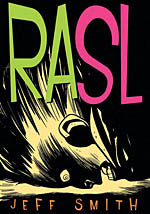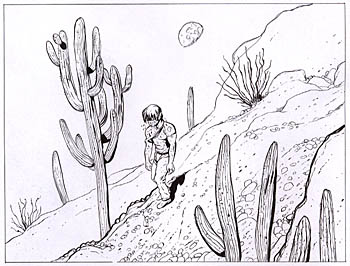 By Jeff Smith
By Jeff Smith
32 pages, black and white
Published by Cartoon Books
It’s probably safe to say, these days, that Jeff Smith can do just about whatever he wants in comics. His first major series, Bone, was a massive success in both the self-publishing world as well as being picked up for color editions by Scholastic Books. Now, having finished a long-promised Shazam! mini-series for DC Comics, Smith could have certainly taken his new project to any published he wanted. Instead, he’s returned to self-publishing and in a serialized format. And somehow, that seems like just the right approach.
Jumping through the Drift isn’t easy. In fact, it seems downright painful. But for one art thief, it’s the easiest way to make a living, leaping across the void into alternate universes and sealing paintings. Leaving behind a graffiti tag stating only “RASL” in his wake, it’s certainly impossible to chase someone who has left your universe behind. Or at least, that’s what our art thief thought, until one jump deposits him into a bad situation—where someone is waiting for him to arrive through the Drift. And that’s when things start getting difficult.
 Smith deposits his readers right into the thick of things with RASL #1, as our art thief begins his heist of a Picasso painting. By starting the series with the heist, it gives readers an instant introduction to the series, understanding its basic concepts and ideas. There’s a narration explaining the idea of jumping through the Drift running concurrently with these first few pages, but thankfully it comes across not like an information dump but instead as if you’re overhearing a conversation between two people, spying on our lead in an unguarded moment. Even once the explanation ends, though, the narration continues—for a book with almost no dialogue (to the point that we don’t even learn the main character’s name in this issue) it works really well in keeping the story flowing and understanding just what’s happening. I was surprised, though, at how quickly it felt like RASL #1 was over. If you sit down and look at it, a lot actually happens in its 32 pages, but the events just felt like they whipped by in no time flat. That’s both a good and a bad thing; it’s to Smith’s credit that the issue flowed so smoothly, but it’s also a tiny bit frustrating to already be at the end of the issue.
Smith deposits his readers right into the thick of things with RASL #1, as our art thief begins his heist of a Picasso painting. By starting the series with the heist, it gives readers an instant introduction to the series, understanding its basic concepts and ideas. There’s a narration explaining the idea of jumping through the Drift running concurrently with these first few pages, but thankfully it comes across not like an information dump but instead as if you’re overhearing a conversation between two people, spying on our lead in an unguarded moment. Even once the explanation ends, though, the narration continues—for a book with almost no dialogue (to the point that we don’t even learn the main character’s name in this issue) it works really well in keeping the story flowing and understanding just what’s happening. I was surprised, though, at how quickly it felt like RASL #1 was over. If you sit down and look at it, a lot actually happens in its 32 pages, but the events just felt like they whipped by in no time flat. That’s both a good and a bad thing; it’s to Smith’s credit that the issue flowed so smoothly, but it’s also a tiny bit frustrating to already be at the end of the issue.
Most interestingly, though, is how I think this works in terms of the decision to serialize RASL instead of releasing it as a series of large graphic novels. In a graphic novel, these pages would feel almost like a prologue, gone before you already know it. Here, it gets to stand on its own as a full chapter, no doubt read and re-read multiple times. It really lets Smith set his own pace in terms of that initial reading, and while I’m rather greedy in wishing for the entire work to be done at once, I can see why having that additional control with RASL‘s pacing is such an attractive concept.

The art in RASL is unsurprisingly nice. Smith’s art has always had a cartoonish quality about it (with his publishing house’s name being Cartoon Books, I doubt he would think that to be an insult!), but here he’s upped the ante a little bit in terms of detail. The broader strokes are still there from before, with smooth ink lines forming gentle curves for his characters’s outlines, as well as the general slick look of the comic. There’s a lot more detail than I remember from a Smith book here, though; all the little nicks and cuts over the main character’s face in the opening scene, the numerous pebbles on the desert floor, the droplets of sweat that bead up on our thief’s brow in times of stress. I also have to give extra special attention to the scene set in the desert; for a book that’s strictly black and white, I was amazed at how well Smith is able to make those scenes feel especially hot and bright compared to the rest of the book. It’s such a perfect depiction of the terrain and background that I was extremely impressed, to put it mildly, at what Smith accomplished here. Add in a wonderful sense of movement (Smith certainly knows how to draw both a chase and a fight scene), and you end up with a book that shows Smith still has what it takes and then some.
RASL #1 was a good debut, although as stated earlier in some ways it felt a little slight. Am I interested? Does it feel like we’re only at the tip of the iceberg? Does it make me want to read more? Absolutely to all three questions. It just feels fun again to have a new Smith comic book hitting stores on a regular basis. I suspect I’m not the only one. Waiting for collected editions may be the norm for a lot of books and creators these days, but RASL is one where I suspect a lot of readers—myself included—will quite happily make an exception.
